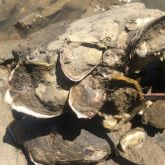

The meat from oysters grown off the bottom in farms tends to be higher, making it a good substitute for dredged oysters. Check for freshness by tapping on the shells to see whether they close. Oysters should be bought live and smell like the sea, not sulfurous. Populations of serpulids can be dense enough to form reefs.A good supply of live half-shell oysters and oyster meat is available year-round. Natural History: Serpulid worms feed by using their feathery appendages to filter particles out of the water. enigmaticus is not considered native in the Gulf of Mexico, it is found globally, and its native range is debated. dianthus is considered native in North America F. miamiensis is native in the Gulf of Mexico H.Serpulids grow on hard surfaces such as oysters, pilings, and rocks. dianthus has a 2-tiered crown shaped operculum.ĭistribution/Habitat: Serpulid worms can tolerate a wide range of temperature and salinities. enigmaticus has black spikes on the operculum, and H. Ficopomatus miamiensis has a smooth round operculum, F. The operculum shape is a key feature used to identify each species. enigmaticus and Hydroides dianthusĭescription: Serpulid worms form a calcium carbonate tube, have feathery appendages, and have a specialized operculum, an appendage used to seal the tube shut. Serpulid worms, Ficopomatus miamiensis, F. They are also a food source for small fish and crabs. Through filter feeding, they help clean the water. leucophaeata feeds by filtering microscopic organisms from the water. Natural History: Mytilopsis leucophaeata can grow in dense aggregations, but populations can be ephemeral and unpredictable. On oyster reefs they are often found tucked into crevices, and beneath Ischadium recurvum. These mussels are euryhaline, meaning they can live in a range of different salinities, and attach to submerged objects like rocks, logs, oyster shells or man-made structures using byssal threads, filaments a bivalve can excrete to cling to surfaces. They are related to, and look similar to the invasive Zebra mussel, but these native bivalves are important to a healthy bay ecosystem.ĭistribution/Habitat: Mytilopsis leucophaeata is native from Mexico to Massachusetts, but invasive elsewhere in the world. Their siphons can be golden/orange, with black speckles. In addition to their ecological significance, oysters are a commercially important fishery.ĭark false mussel, Mytilopsis leucophaeataĭescription: Mytilopsis leucophaeata, also known as the dark false mussel or Conrad’s false mussel, are small bivalves that are dark brown as adults and may be zebra-striped as juveniles. Waves also break on them, reducing erosion and protecting the coastline in storms. These reefs provide a unique habitat for a wide variety of organisms like fish, barnacles, crabs, and other bivalves. Without oyster reefs, Galveston would have few natural hard structures since the bay is mostly covered in soft-sediment. Oysters create physical habitat by creating hard surfaces for other animals to live. Filtration improves water quality and clarity. Through filtration, they remove micro-organisms, nutrients, and sediment particles from the water. One oyster can filter up to 50 gallons of water in a single day. Oysters feed by filtering phytoplankton, microscopic plant-like organisms, out of the water. Natural History: Oysters can build large, complex reefs that provide us with many ecosystem services.

Oyster larvae attach themselves to submerged objects like rocks, logs, man-made structures or the shells of other oysters and then develop into spat, juvenile oysters. Spat is often a dark gray-purple color, with only one valve visible.ĭistribution/Habitat: Eastern oysters are found along the Gulf of Mexico and Atlantic coasts, from Mexico to Canada.

The interior is white with a large purple or darkly colored muscle scar. Description: Crassostrea virginica, the eastern oyster, has a rough grey or white exterior that may be cemented to rocks or other shells.


 0 kommentar(er)
0 kommentar(er)
